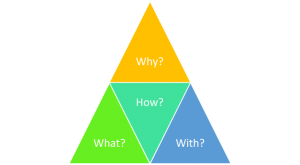Digital is on every company’s agenda, and digital business architecture is the way to lead the enterprise’s digital transformation. However, increasingly, there is a wide gap between the vision for digital transformation and the fact of digital realization. Highfalutin ideas, when elaborated ambiguously and implemented poorly, can result in a less than satisfactory outcome, despite the millions of dollars of investment and enormous effort.
Digital Business Architecture: The Foundation for enterprise digital transformation
Digital business architecture can be a sound basis for translating digital vision into digital reality. At its core, the digital business architecture comprises the following components:

Why? As in general enterprise business architecture, digital business architecture begins with the “Why”? The strategic digital vision, the digital direction, the rationale, and key value drivers. One can use tools such as Osterwalder’s business model canvas, Kaplan/Norton strategy map, or other similar methods that succinctly capture the strategy and business model.
What? Perhaps one of the most critical pieces is the digital business capabilities model. The digital business capabilities model encapsulates the essential capabilities necessary to achieve digital destiny. A digital capabilities matrix is a logical grouping of related capabilities clusters describing the “What.” A digital capabilities map must be mutually exclusive and collectively exhaustive and have structural integrity and internal coherence. A digital capabilities map will help plan a roadmap anchored to stable elements of the enterprise and its capabilities.
How? The concept of how activity flows within the company. It is represented by Value Streams, and a click below, the process maps for several vital workflows. Value Streams are a higher-level activity flow from a stakeholder’s perspective to realize a business outcome.
With? The systems that drive and recognize the capabilities and orchestrate processes. One can generate a footprint matrix by mapping strategies/applications to capabilities and value streams. Furthermore, grouping applications into what Gartner categorizes as systems of record, systems of differentiation, and systems of innovation. This will help us understand each application’s importance in the digital transformation journey.
Other Key Entities: Of course, other components may selectively become necessary in a particular corporation’s digital strategy and realization. For example, Data is a critical piece. We assume that data strategy, architecture, and governance are part of an overall transformation but not necessarily under the umbrella of digital business architecture. Furthermore, concepts like “Who” as in structure, roles, and responsibilities; “Where” such as locations; and “When” as in a phased sequencing are all relevant and necessary.
Digital Business Architecture – Guiding Principles and Practices
Digital transformation is not just nuts and bolts but building a few digital capabilities. A firm must embrace the digital culture, practices, principles, and perspectives to shift the paradigm. Without a fundamental shift in mindset, attitudes, and psyche, the digital transformation will become nothing more than a paint job.
Leadership:
- Establish the need for a digital transformation.
- Communicate the strategic intent of going digital and define a strategic blueprint.
- Support digital endeavors with funding, executive support, and ongoing involvement.
Culture:
- It is not about doing digital but thinking and being digital.
- Customer-centricity and data-driven decision-making should not be a buzzword but an ethos to live by.
- The hiring, reward structure, and governance should foster and promote the digital culture.
Business Strategy, Structure, and Operations:
- Digitally enabled products and services.
- A simple business structure and nimble operational footprint.
- New digitally inspired products and services.
- Flexible business structure and integrated digital business models.
- Enablement of the entire value chain – from the supply chain to the demand chain to be digitally mobilized and enabled.
- Measurement and benchmarking.
Marketing:
- Integrated marketing planning.
- Proactive Social Media Management.
- Brand Ambassadors and Advocates.
- ROI-driven Marketing Spending.
Customer-Centricity:
- A 360-degree view of the customer.
- Mobile enablement. A mobile and touch-oriented interface design.
- Forget multi-channel silos, but focus on an omnichannel solution to customer interactions and transactions.
- A thorough understanding of the client value streams and the bottlenecks involved in the process. For example, value streams such as Prospect to Customer, Search to Purchase, Issue to Resolution, Research to Enjoyment, and Prospect to Advocate are essential to consider and act on.
- Beyond process and technology, customer-centricity results from the people’s mindset and culture. Hence, customer-centric training and change management are essential.
Data and Information:
- Leverage internal and external data to drive decisions, enable interactions, and facilitate transactions.
- Global content management.
- Strategic, tactical, operational, and decision analytics.
IT and Infrastructure Landscape:
- Embrace the cloud.
- Adopt processes like DevOps and Scaled Agile to respond quickly.
- Capability-driven Road mapping.
- Rationalized and optimized application portfolio.
- Platform orientation and API-driven development.
- Information and Cybersecurity are integral to the software, hardware, networking, and infrastructure.
As you consider using digital business architecture to drive your enterprise’s digital transformation, please review Capstera’s Digital Business Capabilities Map as a starting point.




